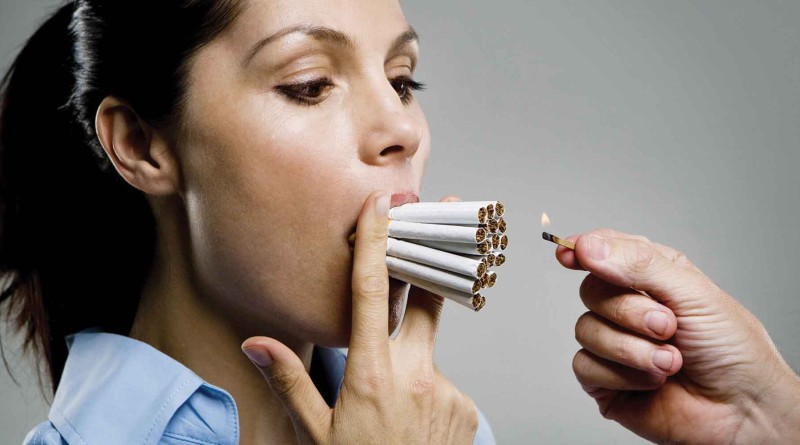Fatal Fixation
Tobacco is a major risk factor for heart attacks, strokes, chronic obstructive pulmonary disease, and cancer. Don’t fall prey to advertisements that seek to glorify its consumption
By Abhigyan
Every year tobacco kills more than five million people, more than tuberculosis, HIV/AIDS and malaria combined. Unless urgent action is taken tobacco could kill one billion people during this century. In people over age 30, smoking accounts for one in every five deaths among men and one in every 20 deaths among women globally.
As per report, there are more than 1.3 billion smokers world-wide, out of which about 80% are residing in low and middle-income countries. According the WHO estimates in 2008, India and China, the two most populous countries contribute to over 40% of the global tobacco users.
Tobacco use is a risk factor for six of the eight leading causes of death in the world. These include ischemic heart disease, cerebrovascular diseases, lower respiratory tract infection, chronic obstructive pulmonary diseases (COPD), tuberculosis and cancer of the respiratory tract (lung, trachea and bronchus). Apart from five million smokers, about 600,000 are non-smokers exposed to second-hand smoke.
Non-communicable diseases (NCDs) kill 35 million people annually, 80% of which are in low- and middle-income countries. Tobacco is responsible for 1 out of 6 NCD deaths. Besides its ill-effect on health, tobacco use costs the world an estimated $500 billion each year in health care expenditures, productivity losses, fire damage and other costs. Tobacco-related illnesses and premature mortality impose high productivity costs to the economy because of sick workers and those who die prematurely during their working years. In India, tobacco consumption is responsible for half of all the cancers in men and a quarter of all cancers in women. About 80% (or 8 out of 10) of all deaths from chronic obstructive pulmonary disease (COPD) are caused by smoking. .Our country also has one of the highest rates of oral cancer in the world, partly attributed to high prevalence of tobacco chewing.
TOBACCO USE IN INDIA
The Global Adult Tobacco Survey India (GATS India) was carried out in all six geographical regions for both urban and rural areas of 29 states of the country and the two Union Territories of Chandigarh and Pondicherry covering about 99.9 per cent of the total population of India. The survey is based on a sample of households which is representative at the national and state levels. GATS India conducted interviews with 69,296 adults aged 15 and above, 33,767 men and 35,529 women aged 15 and above.
The survey reports that the current tobacco use in any form is 34.6% of adults out of which 47.9% were males and 20.3% of them were females. From among the smokers 14.0% of adults were smoking and out of them: 24.3% are males and 2.9% of them were females. The total number of smokeless tobacco users was 25.9% of adults in which 32.9% of them are males and 18.4% are females.
Young people are the most vulnerable segment and adolescence is found to be the most susceptible time for initiating tobacco use. Tobacco use among the adolescents in India is believed to be on an increase. It was estimated in 1999-2001 that approximately 5500 adolescents, some as young as 10 years old start tobacco use every day in our country and nearly 4 million young people under the age of 15 years are already using tobacco regularly. A study conducted in the year 2005 reported the current prevalence of any form of tobacco use among school-going adolescents (aged 13-15 years) in India to be 17.5%. Tobacco use in any form increased in India during the 7-year period between the NFHS-2 and NFHS-3, and the maximum increase in tobacco use occurred in persons between 15 and 24 years of age in the richer classes and in urban areas.
HEALTH CONSEQUENCES OF TOBACCO USE
Unlike many other dangerous substances, the impact of tobacco use on health is not so immediate. It usually takes decades or years after its first use to develop tobacco related disease in a person. Tobacco is used mainly in two forms which are mainly smoked as bidi, cigarette and hookah. It is also used in smokeless form as gul (powdered form tobacco), khaini (tobacco-lime mixtures) which is applied to the oral mucosa, gutka (industrially manufactured and marketed tobacco product), and betel quid which is consisting of fresh betel leaf, lime, catechu, areca nut and tobacco and is chewed in the mouth. In some northeastern states of India a liquid form which is manufactured by passing tobacco smoke in water is also being consumed.
Tobacco smoke contains several carcinogenic pyro lytic products that bind to DNA and cause many genetic mutations. There are more than 7000 chemical substances in tobacco smoke out of which 49 are known or suspected chemical carcinogens. Tobacco also contains nicotine, which is a highly addictive psychoactive drug and is responsible for physical and psychological dependency. Tobacco use leads most commonly to diseases affecting the heart, liver and lungs.
Smoking is a major risk factor for heart attacks, strokes, chronic obstructive pulmonary disease (COPD) (including emphysema and chronic bronchitis), and cancer (particularly lung cancer, cancers of the larynx and mouth, and pancreatic cancer). It also increases the incidence of coronary heart disease by 2 to 4 times and contributes to development of peripheral vascular disease and hypertension. It also increases the incidence of tuberculosis by 3-4 times as compared to non-smokers and the mortality from tuberculosis is shown to be about 3 times higher in smokers than that of non-smokers.
The effects depend on the number of years that a person smokes and on how much the person smokes. Starting smoking earlier in life and smoking cigarettes higher in tar increases the risk of these diseases. Also, environmental tobacco smoke, or secondhand smoke, has been shown to cause adverse health effects in people of all ages. Cigarettes sold in underdeveloped countries tend to have higher tar content, and are less likely to be filtered, potentially increasing vulnerability to tobacco smoking related disease in these regions.
Tobacco use is a significant factor in miscarriages among pregnant smokers, and it contributes to a number of other threats to the health of the fetus such as premature births and low birth weight and increases by 1.4 to 3 times the chance for Sudden Infant Death Syndrome (SIDS). Incidence of impotence is approximately 85 percent higher in male smokers compared to non-smokers, and is a key factor causing erectile dysfunction (ED).
SECOND HAND SMOKE
Smokers are not the only ones harmed and killed by tobacco. Second-hand smoke also has serious and often fatal health consequences. Second hand smoke is the smoke exhaled by a smoker or smoke emanating from the burning end of a cigarette/bidi/cigar. In the United States, second-hand smoke causes about 3400 lung cancer deaths and 46000heart disease deaths a year. In India, smoking is more prevalent among men, therefore women and children are prone to exposure of second hand smoke in their homes.
As per GATS, India Chapter 2010, more than 52% of the adults in India were exposed at home and 29% in public places. Exposure to second hand smoke can lead to cancer and heart diseases among adults and SIDS (sudden infant death syndrome), chronic respiratory infections, worsening of asthma, middle ear diseases and acute respiratory illness in children.
FIGHTING THE TOBACCO EPIDEMIC
The WHO has been giving aid to countries fight tobacco use and the tobacco industry’s marketing of its products. In May 2003, the WHO World Health Assembly unanimously adopted the WHO Framework Convention on Tobacco Control (FCTC); the world’s first against tobacco in order to support action at the global and country level against the tobacco epidemic. The core demand reduction in the FCTC includes price and tax measures and non-price measures to reduce tobacco demand. It comprises of protection from exposure to tobacco smoke in public places or transports, regulation on tobacco product contents and regulation on disclosures, packaging and labeling of tobacco products so as to prevent its promotion, enhancing public awareness and comprehensive ban on tobacco advertising, promotion and sponsorships etc. The core supply reduction provisions in the FCTC includes prevention of illicit trade on tobacco, banning of sale to minors and providing alternative means of economic support to workers engaged in tobacco industries.
In order to spearhead the fight against the current global tobacco epidemic, the WHO has introduced the MPOWER package of six proven policies which basically may be elaborate as the following points:
• Monitor tobacco use and prevention policies,
• Protect people from tobacco smoke,
• Offer help to quit tobacco use,
• Warn about the dangers of tobacco,
• Enforce bans on tobacco advertising, promotion and sponsorship, and
• Raise taxes on tobacco.
This policy package can help reverse the tobacco epidemic and help reduce the mortality from tobacco related diseases.
In order to protect the health of the people from the effect of smoking and to control its use, the Government of India has taken various initiatives for tobacco control in the country. India was among the first few countries to ratify WHO’s Framework Convention on Tobacco Control (WHO FCTC) in 2004. The National Tobacco Control Programme was started during the 11th Five Year Plan which is under implementation in 42 districts of 21 states in the country .The main objectives of the program are to bring greater awareness about the harmful effects of tobacco use and tobacco control laws through mass media, public awareness campaigns etc. It also aims to facilitate the effective Implementation of the Tobacco Control laws in the country. The Centre has also enacted a comprehensive tobacco control legislation titled “The Cigarettes and Other Tobacco Products (Prohibition of Advertisement and Regulation of Trade & Commerce, Production, Supply and Distribution ACT, 2003” in May 2003. The important provisions of this act includes ban on smoking in public places, display of prominent signboard on anti-smoking signage at public places, prohibition of direct/indirect advertisement and sponsorship of tobacco products, ban on sale to minors, mandatory depiction of statutory warnings on tobacco products, specific health warnings on tobacco products and ban on sale of tobacco products with 100 yards of the educational institution.
However, the Act has many limitations which include limited coverage on chewable tobacco products like gutkha and measures on tackling second hand smoke, lack of focus on smokeless tobacco industry, poor compliance from many states and lack of effective implementation of the law by various enforcement agencies in the state. In response to these drawbacks, the Centre has moved to improve on the COTPA Amendment Act 2015 and has proposed radical changes,
Some of the major recommendations include ban on sale of loose cigarettes and raising the minimum age of a person buying tobacco products to 21 years from existing 18, constitution of National Tobacco Control Organization, raising of fine to Rs. 1000 from Rs. 200 on smoking in public places as well as recommending removal of designated smoking zones in hotels and restaurants.


